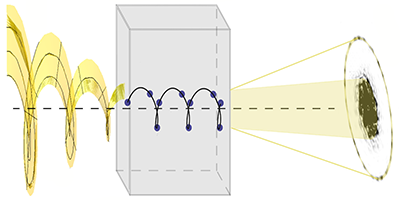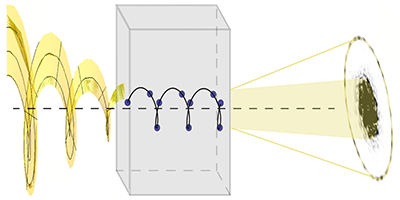Probing Chirality with Electron Vortices
Chiral molecules, like our hands, come in two versions (“enantiomers”) with different handedness. Chirality can affect a molecule’s chemical behavior and is thus important in medicine and biology; for instance, only one of the two enantiomers of a drug molecule might bind to a targeted receptor. A new method, demonstrated by Jo Verbeeck and colleagues at the University of Antwerp, Belgium, could allow researchers to determine the chirality of crystalline samples using transmission electron microscopy (TEM). The scheme exploits so-called electron vortices, which have a “corkscrew” shape that makes them sensitive probes of a crystal’s handedness.
Electron vortices are beams of electrons that, thanks to their spiraling wave front, carry angular momentum. The authors modeled the pattern of diffracted electrons that are observed when a focused electron-vortex beam scatters from chiral crystals. Their analysis showed that left- and right-handed enantiomers generate patterns with different symmetries, providing a way to distinguish them. The technique also has an important advantage: it can determine the handedness of extremely thin samples, allowing the investigation of very small volumes of materials—potentially as small as a single molecule. The researchers demonstrated the technique experimentally by feeding an electron-vortex beam into a TEM and using it to analyze a chiral magnet ( ), showing their sample was of the right-handed variant. TEMs with chiral sensitivity might become useful in the analysis of biochemical drugs, in which chemicals can be active, inert, or even harmful, depending on their handedness.
This research is published in Physical Review B.
–Matteo Rini





